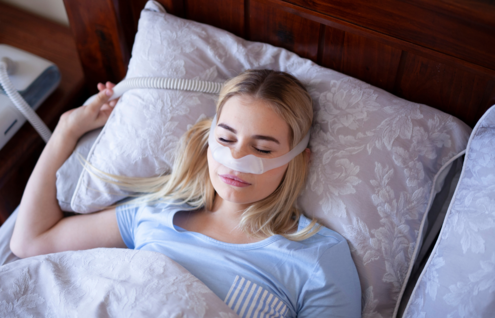
One of the most common sleep disorders, obstructive sleep apnea (OSA) affects nearly 30 million Americans.
But, according to SleepApnea.org, 40.3% of adults diagnosed with sleep apnea have not tried or been prescribed any treatment. The most common treatment for OSA is a CPAP (Continuous Positive Airway Pressure) machine. Available in styles designed for back sleepers, side sleepers, those who toss and turn, mouth-breathers, and more, CPAP machines aren’t just game-changers for getting a solid night’s sleep. They can lead to improved quality of life and better health.
Here’s how you can benefit from CPAP therapy:
Improved Sleep Quality
By preventing breathing pauses during sleep, CPAP therapy provides a more restful, uninterrupted sleep. Many CPAP users report feeling more refreshed and energetic upon waking.
Reduced or Eliminated Snoring
A hallmark symptom of OSA, snoring can be dramatically reduced or eliminated when using a CPAP.
Increased Daytime Energy and Improved Alertness
By restoring normal breathing and sleep cycles, CPAP therapy helps users feel more alert, energetic, and productive during the day.
Enhanced Mood and Cognitive Function
As untreated sleep apnea is linked to mood disturbances, irritability, depression, and problems with memory and decision-making, regular CPAP use can improve emotional stability, reduce symptoms of depression and anxiety, and enhance cognitive performance.
Reduced Risk of Serious Health Complications
OSA is linked to increased risk of high blood pressure, heart disease, stroke, and type 2 diabetes. CPAP therapy has been shown to lower blood pressure, improve heart function, and may reduce the risk of cardiovascular events such as heart attacks and strokes. Additionally, CPAP can improve insulin sensitivity and help regulate blood sugar, which is particularly important for those living with or at risk of diabetes.
While getting used to a CPAP machine can take time, there’s a lot of great information and support available through your doctor and machine provider. Some people have to try several different types of masks before finding the one that works for them. It’s important to communicate any problems or challenges with your doctor as they occur. They can suggest strategies and ideas to make using your device easier.
To learn more about the causes and diagnosis of OSA, click here.
Caitlin E. deBros, DNP, AGACNP-BC, is a member of the pulmonology team at Southwestern Vermont Medical Center.